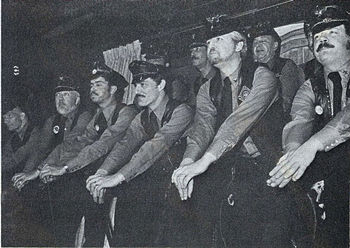Difference between revisions of "WisLGBT Sidebar: The Leather scene"
(New page: '''Wisconsin LGBT History SIDEBAR''' == The Wisconsin Leather scene == thumb|right| We all know and instantly recognize the uniform of th...) |
|||
| Line 3: | Line 3: | ||
== The Wisconsin Leather scene == | == The Wisconsin Leather scene == | ||
| − | [[Image:gpunews-7806-p13-silver-stars-pic3.jpg| | + | [[Image:gpunews-7806-p13-silver-stars-pic3.jpg|350px|right|]] |
We all know and instantly recognize the uniform of the leatherman-- all manner of black leather wear with silver studs liberally sprinkled in: vest, with no shirt or (usually white) t-shirt; black leather chaps over faded blue jeans; black boots; the cockily worn black leather hat. This was also the primary vehicle for the hankie code (the color and position of a hankie in the back pockets could signal whether you were a top or bottom, and what you were generally “into” sexually.) While sometimes identified with the motorcycle (and thus the genesis of motorcycle or biker groups), the gear is readily found in any "levi-leather" men's bar in the U.S. on any given night (although most often seen on a Friday or Saturday night). A close relative of this is of course the uniform look (sometimes military, but more often the police look). | We all know and instantly recognize the uniform of the leatherman-- all manner of black leather wear with silver studs liberally sprinkled in: vest, with no shirt or (usually white) t-shirt; black leather chaps over faded blue jeans; black boots; the cockily worn black leather hat. This was also the primary vehicle for the hankie code (the color and position of a hankie in the back pockets could signal whether you were a top or bottom, and what you were generally “into” sexually.) While sometimes identified with the motorcycle (and thus the genesis of motorcycle or biker groups), the gear is readily found in any "levi-leather" men's bar in the U.S. on any given night (although most often seen on a Friday or Saturday night). A close relative of this is of course the uniform look (sometimes military, but more often the police look). | ||
Revision as of 19:25, 17 March 2010
Wisconsin LGBT History SIDEBAR
The Wisconsin Leather scene
We all know and instantly recognize the uniform of the leatherman-- all manner of black leather wear with silver studs liberally sprinkled in: vest, with no shirt or (usually white) t-shirt; black leather chaps over faded blue jeans; black boots; the cockily worn black leather hat. This was also the primary vehicle for the hankie code (the color and position of a hankie in the back pockets could signal whether you were a top or bottom, and what you were generally “into” sexually.) While sometimes identified with the motorcycle (and thus the genesis of motorcycle or biker groups), the gear is readily found in any "levi-leather" men's bar in the U.S. on any given night (although most often seen on a Friday or Saturday night). A close relative of this is of course the uniform look (sometimes military, but more often the police look).
A staple of the leather/levi scene, much like the drag scene, has long been the leather titles: sometimes bar-based titles (such as Mr. Eagle, or Mr. Harbor Room, etc.), but more prominently state (Mr. Northwoods, Mr. Daddy and Daddy's Boy), regional, and national titles. As with the drag and pageant scene, there is a careful succession and hierarchy of titles; to compete at a national level one must usually have a state or regional title for example.
Leather titles and dress, and various other gay stereotypes, are all indicative of a gradual acceptance of gay and lesbian people into general society, and thus a lessening of the need to make ourselves stand out to make a statement. We can be more comfortable with who we are without being “in your face” about our differences. But let’s not forget how we got where we are now- let’s embrace and enjoy the occasional drag show, leather event, etc. Let’s recognize that those “stereotype” extremes were one factor contributing to mainstream society’s increased acceptance of us.
- Return to PEOPLE page: Wis. LGBT History-- People
- Return to INTRO page: Wisconsin LGBT History Project- Intro
Explore the full web site documenting GLBT life in Milwaukee, Madison, Green Bay, and all of Wisconsin at: http://www.WisconsinGayHistory.org
Source: unless otherwise noted, all contents of this page copyrighted by Don Schwamb of the Wisconsin LGBT History Project.
